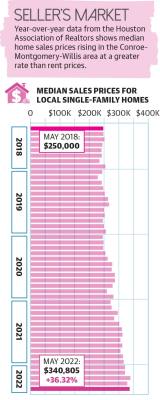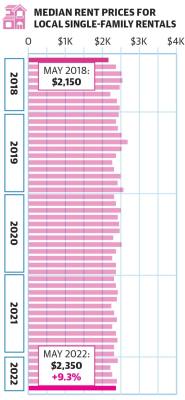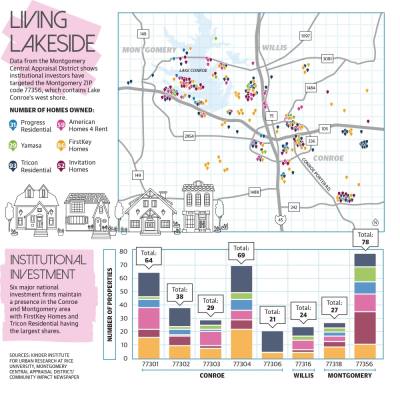Large investment firms are converting single-family homes to rentals and building communities to rent in the Conroe and Montgomery area to help meet the rising rental demand, while the housing shortage is driving more people to rent in the Houston area, real estate experts said.
The Houston Association of Realtors reported June 15 the number of leased single-family home rentals in the Houston area increased 24.8% from May 2021 to May 2022. While rising mortgages and low inventory are contributing to the trend, experts said potential homebuyers are also facing competition from real estate investment firms, or institutional buyers, buying properties to sell or lease.
“These are not mom and pop buyers,” said Nadia Evangelou, the director of forecasting at the National Association of Realtors. “They look to buy properties and communities on a large scale and make profit from them.”
Texas leads the nation in institutional buying with 28% of single-family homes purchased by institutional investors in 2021—more than double the national average of 13%, according to data from the NAR. Locally, NAR data showed 29% of single-family properties purchased in Montgomery County in 2021 were bought by institutional buyers.
Montgomery Central Appraisal District data shows 350 homes in the eight ZIP codes that make up the Conroe and Montgomery area are owned by six institutional buyers and subsidiaries verified through the Securities and Exchange Commission: American Homes 4 Rent, Progress Residential, FirstKey Homes, Yamasa, Invitation Homes and Tricon Residential.
Realtor Abbie Holland of Holland Homes in the Conroe-Montgomery-Willis area pointed to factors such as inventory issues and rising interest rates that “restricted” buying choices, forcing people to rent homes often owned by investors.
“It’s hard to build right now with prices as high as they are, which means you’re going to see your single-family active listings moving [off the market] quickly,” she said.
However, David Howard, executive director of the National Rental Home Council—a nonprofit that represents the single-family rental home industry—cited member-provided data to show 1.3% of single-family homes nationwide are owned by large companies.
Howard highlighted the rise of build-to-rent communities with 26% of homes in NRHC company portfolios representing the category as of the fourth quarter of 2021 versus 3% in 2019.
The development firm Wan Bridge, which builds rental communities throughout Texas, unveiled the Montgomery waterfront rental development Lakeside Conroe in September. Wan Bridge CEO Ting Qiao said in an email that the company wanted to offer more options to people looking for higher standards of rent.
“Back [in 2016], I knew build-to-rent was the future,” he said. “Unlike apartment renters who had options from luxury apartments to more affordable options, home renters had very few choices. I wanted to offer people a new lifestyle in both product and service.”
Invitation Homes and American Homes 4 Rent did not respond to a request for comment, and FirstKey Homes referred Community Impact Newspaper to the NRHC for comment.
First-time buyer options
Holland said market trends in the Conroe and Montgomery area, such as rising interest rates, fluctuating rents and fast home sales, made the area a target for institutional buyers.
“What you have to understand is that [mortgage rates] were under 3%. ... If you have a good credit score, you’re at 2.75%-3% interest in 2019-20,” Holland said. “And then all of a sudden in 2022, you’re over 6%; you’ve doubled your interest rates, and you no longer qualify for the home you wanted to buy.”
Data from the Multiple Listing Service, which shows real estate listings, found the average amount of days a single-family property spent on the market as of June was under 30 days for both Conroe and Montgomery.
Steve Sherman, a researcher with the think tank Kinder Institute for Urban Research at Rice University, said advances in algorithms allow investors to identify target properties as soon as they hit the market.
“[Investment firms] look for a home that will gain value over time, even if they’re renting it out,” he said. “[These firms] can hold on to properties for a while, even when they’re vacant, because they’re thinking on a massive scale.”
The ZIP code 77356, which covers Lake Conroe’s west shore, has 78 homes owned by the six investment firms—the most among Conroe and Montgomery ZIP codes. Shannon Register, the owner of Houston-area real estate agency Register Real Estate Advisors, pointed out trends in lower-priced new construction in communities such as Bentwater, a master-planned community built near Lake Conroe.
"New development in the Lake Conroe area is a lower price point, smaller home," Register wrote in an email. "In large communities, like Bentwater, we are seeing a lot of new construction in the [$275,000-$400,000] price range that people are looking for. The homes are smaller square footage with more functionality."
Qiao said Lakeside Conroe, which offers 169 single-family rentals, also began in the area because of the amenities near Lake Conroe.
“This is a great location for residents and families beginning the next chapter of their lives—whether that means a second vacation home, retirement, starting a family or just wanting to live the lake life while working remotely,” Qiao said.
In addition to Lake Conroe, certain parts of the Conroe area have seen affordable housing targeted with the south Conroe ZIP codes 77304 and 77301 having the second- and third-most homes purchased, respectively. MCAD data shows all homes purchased in these ZIP codes were appraised below $300,000 in 2022.
MLS data showed single-family monthly rent prices in the Conroe-Montgomery-Willis area never increased above $2,663 from May 2018 to May 2022 and increased about 9% over that time. Median home sales prices increased 36% during the same time period.
Holland estimated a Conroe and Montgomery home purchased for $300,000 at a 5.75% mortgage interest rate and a 5% down payment would have monthly mortgage payments of $2,667.56, including a $2.72 per $100 valuation tax rate and insurance.
“This becomes a great opportunity for an investor because they can buy 10 or 15 homes in an area and provide housing because they know it would be out of [buyers’] reach otherwise,” Holland said.
Rise in communities for rent
Charlie Kriegel, who partners with firms including Wan Bridge and Tricon Residential for the Houston property adviser firm Winhill Advisors-Kirby, said his clients see build-to-rent as a “windfall” for a return on investment.
“[Build-to-rent] allows investors to control cost [and] absorption rate, so it’s going to be the fastest-growing segment for the next five years,” Kriegel said.
HAR data released June 15 showed new single-family rental listings in the Houston area increased 28.6% from May 2021 to May 2022. Evangelou said institutional buyers focusing on rental properties are contributing to surging rentals.
“They create more rental housing, so even if rents rise, there is more supply,” Evangelou said. “With rising mortgage rates, it gives more options for people.”
An April study conducted by researchers at the University of California at Berkeley found firms such as Tricon had invested millions of dollars as of the fourth quarter of 2021 in developing U.S. homes specifically for rent. The company owns 231 homes in Montgomery County and 93 in Conroe and Montgomery, according to MCAD data.
Qiao said build-to-rent communities targeted people who “had high standards of living,” pointing out Wan Bridge homes offering amenities of traditional homes as well as services such as lawn care and maintenance.
“In the past, people who had high standards of living had very few choices other than purchasing a home,” Qiao said. “Wan Bridge truly believes you don’t have to own to call it home.”
Qiao also pointed out changes in rent and a desire for more space for apartment renters as factors driving the demand for build-to-rent communities.
"It is worth noting that while the pandemic accelerated BTR, we started executing our strategy years before," Qiao said. "We've identified a few key trends that resulted from the pandemic. First, apartment renters needed more space. Many of them were working from home and wanted to spend more quality time with their families. Second, some homeowners sold their bigger homes and moved into our build-to-rent products to make them feel more secure in times of uncertainty. Third, there has been a shortage in housing inventory in addition to FED increasing rates. Many home buyers decided to delay their home purchasing plan, opting to rent a home."
Long-term impacts
Kriegel said while real estate firms are pivoting toward build-to-rent communities, local government officials in the Houston area have implemented regulations that could make the communities less attractive to developers, such as lot size control. However, Kriegel said developers will usually find “loopholes’’ in city ordinances or will move outside their jurisdiction to avoid restrictions.
“We look at the restrictions that they put in place, and there’s always ways for people to get building plans approved,” Kriegel said. “There needs to be some common ground between city officials and investors to make sure that what they’re building matches the absorption rate and what the market will demand.”
The city of Conroe voted May 26 to increase its minimum lot width size for a subdivision from 40 feet in width to 50 feet. Holland said larger lots could lead to higher price points—which are less favorable for developers—which in turn could hold both cities and developers “more accountable” for how they structure developments.
“It’s hard. You want growth; you want development; and you want a good price for the city of Conroe, but it’s also the city’s responsibility to be attractive, to bring higher-paying jobs so people can afford to live here,” Holland said.








